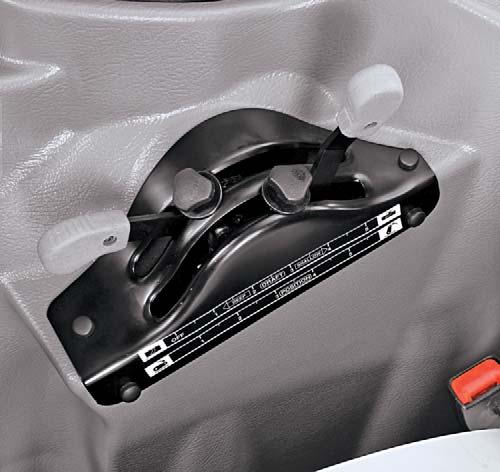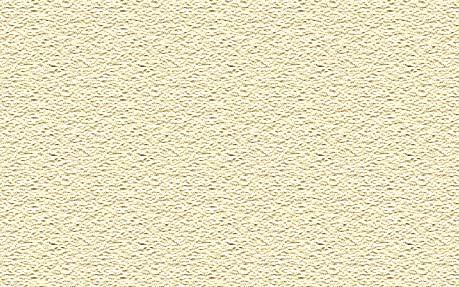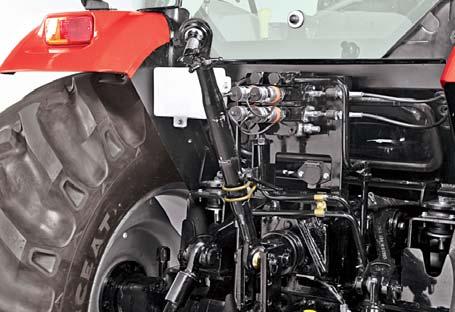
4 minute read
Position Control - Operation
from Mahindra Tractor‘8000’ Series 8090 8100 4WD CABIN TIER-4 FINAL Operator's Manual - PDF DOWNLOAD
Quadrant Assembly
This system incorporates a Position control and a Draft control. Both these controls are within easy reach of the operator.
The operator must be thoroughly acquainted with the location and use of all controls regardless of experience, must read this section carefully before attempting to operate the tractor.
Position Control
This lever (D) controls the lifting and lowering of all implements used on the three point linkage.

1.Moving the lever Forward will lower the implement.
2.Moving the lever Rearward will raise the implement.
The control can also be set by PC stop screw (C) to govern the height of out-of-ground implements such as mowers, rakes etc., so that the implement can be lowered to exactly the same height at the commencement of each run.
PC lever (D) should be used for the following applications:
1.TRANSPORT of implements and turn around at the end of the field.
2.CONSTANT DEPTH of implements on level terrain and for non-ground engaging implements such as spreaders or sprayers. Place the PC lever at desired depth.
Setting of Position Control
1.Move the DC lever (A) to its most forward position.
2.Move the PC lever (D) back to the upper limit and allow the implement to lift fully.
3.Move the PC lever (D) forward until the implement has reached the desired working height.
4.Set the position control stop screw (C) against the PC lever & tighten the knob.
Whenever the lever is returned to the stop from the lift position, the implement will return to and remain at the preset height.
Draft Control
As the draft of the implement varies due to irregularities of ground contour, soil texture, or pitching of the tractor, the load on the top link of the three point linkage will vary. These changes are transferred through the internal mechanism into hydraulic valve movement. By means of the top link, the draft control system reacts not only when the top link is in compression, as is usually the case, when plowing, but also when the top link is in tension, as with shallow working implements. An increase in implement draft will increase the compression or reduce the tension on the top link and the system will go to lift. Conversely, a decrease in implement draft will cause the system to go lower.
Due to setting of the draft control lever, the load required to maintain the valve in the hold position is governed. Therefore, the load the tractor has to pull is maintained irrespective of ground contour, soil conditions, or the pitching of the tractor.
The lever is moved Forward to deepen the implement and Rearward to shallow it.
Setting of Draft Control
1.Move the PC lever (D) to its most forward position.
2.Move the position control stop screw (C) to the front of the quadrant and lock it.


3.Lift the implement off the ground by pulling the PC lever back to upper limit.
4.Lower the implement into work by moving the PC lever to its most forward position. The faster the lever is moved Forward the quicker the implement will drop.
5.Move the tractor slowly in forward gear. When the implement has reached the desired working depth, move the draft control lever (A) rearward, until the linkage begins to lift, due to the load on top link. This will be the position of the lever for that particular depth in a particular type of ground.
6.Having obtained a desired setting move DC Stop screw (B) until it touches the DC lever (A) and lock it in this position.
When the soil texture remains constant, the implement is partially carried on the three point linkage. Therefore, proportion of the implement weight is transferred to the tractor rear wheels to improve traction. When a condition arises which causes an increase in draft, the system will go to lift and all the weight of the implement will be transferred to the tractor rear wheels to provide maximum traction. As soon as the draft returns to normal, the system goes to lower position and the situation returns to its former condition.
When the front wheels of the tractor drop into a furrow, the tendency for the implements is to lift out of the ground. As the implement lifts, the draft decreases and the system goes lower to maintain the pre-set depth. If the rear wheel drops into a furrow, the reverse will occur. Thus under all operating conditions, the “Vary-Touch” system provides maximum traction and constant implement depth.
Do not transport or attach equipment when the hydraulic system is in Draft Control. Use Position Control for these operations. Always lower hydraulic equipment to the ground before stopping the Tractor.
Under No Circumstances must the Draft Control Lever be used to Lift the implement to its uppermost Position. To do so will cause overheating of the system. All movements into and out of the soil must be made by using the Position Control lever.
Toplink




It is used to attach the implement and control its inclination front-to-rear with respect to ground. The distance between its two ball-joints can be increased or decreased by rotating the turn-buckle as follows,
1.Loosen the locknut (A).
2.Clockwise rotation of turn buckle will decrease the distance.
3.Anticlockwise rotation will increase the distance.

4.Tighten the locknut (A) after desired adjustment.
Draft Sensing Bracket
Draft sensing bracket transfers the toplink force to the draft sensing mechanism. It has three holes (A), (B) and (C) for hitching the toplink.
Maximum achievable depth of implement increases as the toplink is shifted from top to lower holes.
Top Hole (A):Attach toplink to hole (A) where higher and medium draft sensitivity is required Viz. Cultivator in soft soil.
Centre Hole (B):Attach toplink to hole (B) where medium to Low draft sensitivity is required Cultivator in Hard soil and Plow in soft soil.
Lower Hole (C):Attach toplink to hole (C) where very Low draft sensitivity is required Viz. Plow in hard soil.
Contact your Mahindra dealer to understand hitching position of toplink for specific implements used by you.

Telescopic Lower Links
Telescopic Lower Links are provided for ease of hitching the implement as follows,
1.Slowly back tractor into position to align the lower links with implement pins.
2.Park tractor safely.
3.Raise lock lever (D) and pull link (E) to extend as needed.
4.Connect lower links to the implement. Sit on operator’s seat and start engine.
5.Back tractor until each lock lever snaps and secures each lower link in the lock position.
The lower link is available with adaptability of Cat–II implements.








